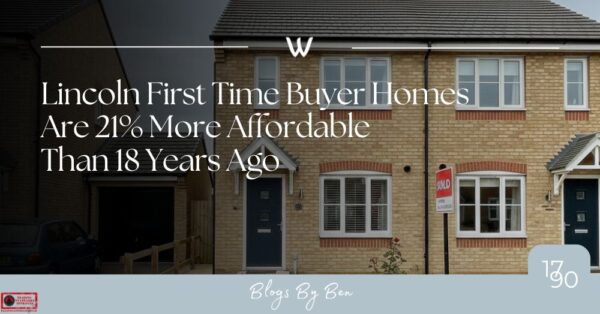The property market is one of the most important economic indicators, as it can significantly impact the prosperity of both the local and national economy.
Recently, new data from the Census 2021 has become available that sheds light on seldom discussed areas of property, such as the types of properties Lincoln has, together with how we live in and use our homes.
This data could be of interest to all Lincoln people. However, it should be fascinating to Lincoln homeowners and landlords, as it can help them make informed future decisions about buying, selling, and renting property.
Furthermore, comparing the data to the national statistics can provide a broader perspective and a better understanding of how we live in our homes in Lincoln.
In this report, I will analyse seven measurements from the new Census data to assess the city’s housing stock and provide valuable insights for potential buyers and sellers.
The seven metrics I have selected provide essential information about the city’s demographics, housing types, and tenure.
- Population and households of Lincoln.
Knowing the population of a city is essential for a variety of reasons. Primarily, it helps us understand the demographic makeup of Lincoln. This information is crucial for local authority officials and businesses as they decide where to allocate resources and how to serve the community’s needs (like whether we need to build more new homes, for example).
Looking at demographics allows for better long-term planning and development (and for savvy buy-to-let Lincoln investors to spot opportunities years in advance). Additionally, population data can help identify trends and changes in the community over time (I will revisit this in future articles where I will discuss the growth of Lincoln over the last few decades and what that means for the property market and long-term house prices). Finally, having accurate population figures is necessary for allocating government funding and resources, making it critical for our city’s overall health and well-being.
The population of Lincoln currently stands at 104,600 in 42,800 households.
- The age profile of the people who live in Lincoln.
The age profile of a city’s population provides valuable insights into the local property market. For example, suppose the city has a large population of retirees. In that case, it is more likely to have a higher demand for bungalows or sheltered accommodation. In comparison, a city with a large student population may have more demand for shared accommodation. Knowing the age profile of the city’s population is crucial for targeting the right buyers and understanding the potential market for diverse types of properties.
14.4% of Lincoln’s population is 65 years and over, compared to the national average of 18.4%.
Again, I will delve into this in more detail in my articles on the Lincoln property market in the coming months.
- Lincoln household composition – one-person households vs family households.
Understanding household composition is crucial for predicting the demand for different properties. For example, if the city has a large population of single people, there may be more demand for one-bedroom apartments or studios. However, if the city has many families, there may be more demand for three or four-bedroom houses and schools.
33.1% of Lincoln households are one-person households (compared to 30.2% nationally), and 57.2% of Lincoln households are single-family households (compared to 63.0% nationally).
The remainder is made up of shared accommodation etc.
- Lincoln accommodation types – house or apartment.
Knowing the accommodation type is critical in understanding the local property market’s demand and supply. For example, if the city has many apartments, it may indicate that the city has a higher demand for properties with lower maintenance costs or land is too expensive to build houses on. Conversely, if the city has a higher than the national (or regional) average number of houses, it may indicate that it has more families looking for larger properties.
80.5% of the homes in Lincoln are houses (Compared to the national average of 77.9%).
- Number of bedrooms in Lincoln.
The number of bedrooms is another crucial factor that affects the local property market. Knowing the average number of bedrooms in the city can help predict the demand for different property types. For example, if the city has many four or five-bedroom properties, it has more affluent buyers looking for larger properties.
- 12.7% of Lincoln homes are one-bed households (11.4% nationally)
- 31.2% of Lincoln homes are two-bed households (27.1% nationally)
- 39.4% of Lincoln homes are three-bed households (40.4% nationally)
- 16.6% of Lincoln homes are four-bed or more households (21.1% nationally)
- Occupancy rating for Lincoln bedrooms – whether a property is under-occupied or overcrowded.
Knowing the occupancy rating for bedrooms is critical in understanding the local property market’s demand and supply. For example, if the city has many under-occupied properties, it could indicate people living in homes too big for their daily needs.
31.5% of Lincoln homes have two or more spare bedrooms (Compared to the national average of 42.7%).
- Tenure of Lincoln households – whether owned outright, owned with a mortgage, social housing or privately rented.
Understanding households’ tenure is essential in understanding the local property market’s demand and supply. For example, if the city has a high number of households in social housing, it may indicate that there is less demand for private rental properties. Conversely, if the city has an increased number of households owning properties outright, it usually suggests that there are more older homeowners (compared to younger homeowners)
- 26.0% of Lincoln households own their home without a mortgage (compared to 32.8% nationally)
- 25.6% of Lincoln households own their home with a mortgage (compared to 29.7% nationally)
- 20.9% of Lincoln households live in social housing (compared to 17.1% nationally)
- 27.5% of Lincoln households live in private rented accommodation (compared to 20.4% nationally)
So, what is all this telling us?
The seven metrics discussed in this article on Lincoln provide valuable insights into the city’s demographics and the future of Lincoln’s property market’s demand and supply.
As a Lincoln estate agent, having a deep understanding of these metrics can help me better target potential buyers, predict the demand for several types of properties and provide valuable insights and advice to Lincoln house sellers, buyers, and buy-to-let landlords.
If you are considering moving home in 2023 and want to know how this data will affect your buying or selling decisions, please do not hesitate to contact me for a personalised no- obligation no-cost consultation.
I am here to help you make informed decisions and find your dream property in this thriving city of Lincoln.


